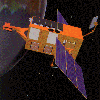 |
||
| First page | ||
 |
||
| Chandra | ||
 |
||
| Hubble Space Telescope | ||
 |
||
| Infrared Space Observatory | ||
 |
||
| Integral | ||
 |
||
| International Ultraviolet Explorer | ||
 |
Next Generation Space Telescope | |
 |
||
| XMM-Newton | ||
 |
||
| X-ray Timing Explorer | ||
 |
||
| Want to know more? | ||
 |
||
 |
||
The Rossi X-ray Timing Explorer Mission
(1995-present)
Named after astronomer Bruno Rossi, the Rossi X-ray Timing Explorer (RXTE) makes sensitive measurements of how cosmic X-ray sources behave over time. It observes processes and structures in white-dwarf stars, X-ray binaries, neutron stars, pulsars, and black holes. Among other things, RXTE will investigate:
* Characteristics of X-ray binaries (orbital properties, exchange of matter between them)
* Inner structure of neutron stars and properties of their magnetic fields
* Behaviour of matter just before it falls into a black hole
* Effects of general relativity which can be seen only near a black hole
* Properties and effects of supermassive black holes in the centres of active galaxies
Astronomers study changes that happen from microseconds to months in cosmic objects to learn about how gravity works near black holes, how pulsars in binary systems are affected by mass transferring from one star to the other, and how the giant engines in distant galaxies are powered.
About the satellite
The RXTE weighs more that 3000 kg and was launched in december 1995 with some help from a Delta II rocket and put into low-earth orbit. The RXTE is maneuverable, so that it can point to a chosen source rapidly. This flexibility allows the instrument to respond to short-lived or new phenomena as they are discovered. Because of the Sun's x-ray brightness the RXTE cannot point at less than 30 deg toward the Sun.
RXTE links
The Rossi X-Ray Timing Explorer Project (Official homepage)
The XTE Learning Center has a lot of good information that is easy to understand.
28th July 2000
Emma Button
Sarah Amandusson
www_astro@mssl.ucl.ac.uk